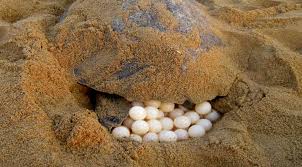Kendrapara: The adverse weather conditions and torrential rain caused by Cyclone Remal in the Bay of Bengal have severely disrupted the emergence of Olive Ridley turtle hatchlings at the mass nesting sites of Nasi-2, the world’s largest rookery of the species in Odisha. DFO of Rajnagar Mangrove (forest) and Wildlife Division, Sudarshan Gopinath Jadav, said the turbulent sea, along with high tides due to Cyclone Remal, washed away several eggs. The incessant rain also damaged the turtle eggs, he added. Official sources said about 1.20 lakh Olive Ridley sea turtle hatchlings emerged from the eggs at the mass nesting sites of Nasi-2 three days ago.
However, the prevailing adverse weather conditions due to Cyclone Remal have halted the emergence of the baby hatchlings from the pits. “We are now in a wait-and watch situation with fingers crossed, as we anticipate the eggs might have been destroyed due to Cyclone Remal,” Jadav said. Around 3 lakh Olive Ridley sea turtles came ashore en-masse to the golden beach of Nasi-2 within Gahirmatha Marine Sanctuary and laid eggs over five days, starting April 2. The mass nesting process of the sea turtles was also affected by the adverse weather, Jadav noted.
According to Jadav, the hatchlings of the endangered Olive Ridley sea turtles started emerging six days ago at the tranquil sandy nesting ground at Nasi-2, located close to the Defence Research and Development Organisation (DRDO) at Wheeler’s Island under the Gahirmatha Marine Sanctuary. He said it was expected that the process would continue for at least the next five days, but Cyclone Remal has disrupted the emergence of the baby turtles from their eggshells.
Earlier, due to multi-layering at Nasi-2, more than 15 per cent of the eggs laid were destroyed in some segments during the mass nesting, as turtles were seen laying eggs on the same spot, digging the earth with their flippers, and destroying previously laid eggs. Female Olive Ridley sea turtles generally lay 100–120 eggs at a time. They lay their eggs at midnight in 45-cm pits, which they dig 2-3 feet deep with their rear flippers.
Hatchlings emerge from the eggs after 45–55 days and find their way to the sea, creating a cacophony, the DFO said. Once hatched, the turtles dig their way to the surface and scurry to the ocean. It is believed by some that imprinting on the Earth’s magnetic field may occur upon their emergence from the sand. This imprinting is thought to guide the hatchlings back to the same breeding areas in adulthood. If the hatchlings reach the ocean successfully, they will spend the next several years dispersing in ocean currents, associating with sargassum rafts and floating debris, which provide them with food and shelter, Jadav said. It is one of nature’s rare phenomena where babies grow without their mother. The endangered species’ mortality rate is so high that only one out of every 1,000 eggs laid hatches and survives to become an adult Olive Ridley turtle, Jadav explained.







































